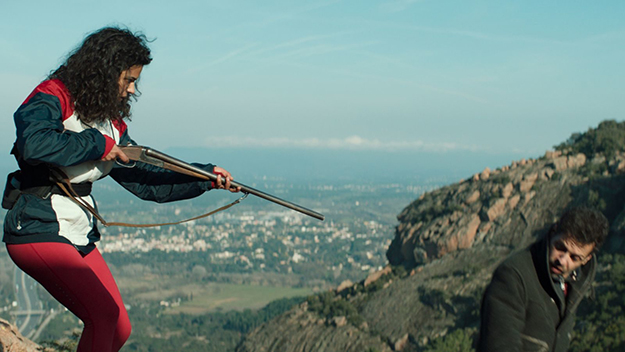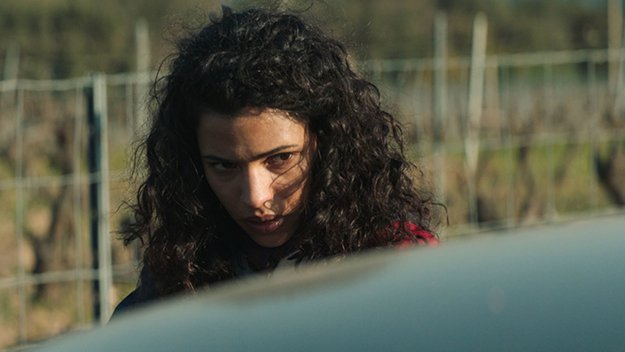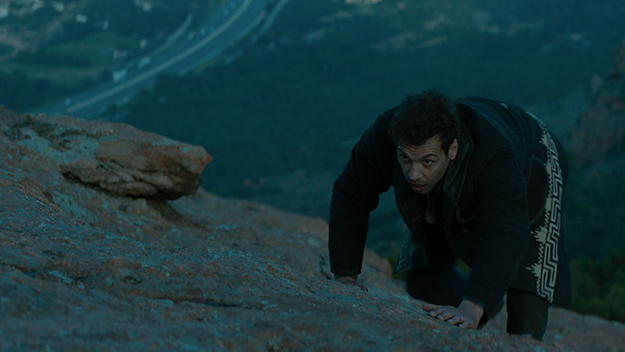Interview: Patricia Mazuy

Madness is contagious in Paul Sanchez Is Back! (2018), Patricia Mazuy’s tragicomic account of a fugitive killer’s return to civilization. Spotted in the Var region of southern France a decade after slaughtering his wife and four children, Paul Sanchez (Laurent Lafitte) becomes the existential obsession of Marion (Zita Hanrot), a female gendarme in pursuit of adrenaline and glory. Taking advantage of his notoriety to contact a local reporter who happens to be Marion’s lover (Idir Chender), the chameleon-like Sanchez sends the young woman down a spiral of manipulation that constantly blurs the lines between truth and fiction, private and public, politics and myth-making. A bewildering combination of the cerebral and the impulsive, Hanrot’s relentless performance emerges as a highlight of the film, whose most compelling moments belong as much to the realm of psychology as to that of action. A microcosm of contemporary France with echoes of materialism and corruption, the Var hinterland assumes the form of a mental prison from which there is no escape—the shifting landscape of Marion’s consciousness as she tracks down Sanchez.
Before Paul Sanchez Is Back!’s screenings at Rendez-Vous with French Cinema on March 8 and 9, Mazuy welcomed me into her Parisian home for a conversation about her directorial process and her sporadic yet confident filmography that includes the Isabelle Huppert-led period drama The King’s Daughters (2000).
The return of the eponymous protagonist in Paul Sanchez Is Back! represents a return of the repressed—the brutal, cathartic eruption of long-buried words. Speech becomes a therapeutic action, a way for Sanchez to free himself from his traumas as well as live out his fantasies. How did you develop Sanchez’s monologues? Was it tricky to mold them into a simultaneous expression of intimate and collective experience?
Sanchez’s logorrheas were written by my co-writer, Yves Thomas, who also came up with the idea for the film. His wife has a house near the Rocher de Roquebrune where Sanchez hides out and he had taken his kids there before, so he was familiar with the setting. Yves came to a writing session with a piece of paper on which he had scribbled [Sanchez’s dialogue], and I looked at it and said: “This is disgusting. We’re not touching it, it’s great.” It was an outpouring of his heart and soul, which is why we kept it intact. Paul Sanchez is someone whose voice has never been heard and who yearns to unleash his vomit onto the world. But when he does, it was important that it didn’t sound like spoken language—he has been romanticizing that moment for so long that he expresses himself in an almost literary way. It was difficult in the acting to preserve the literariness while not falling into something theatrical, because Sanchez’s words had to come out in the present and not feel fabricated.
Did you always envision the title with an exclamation point?
Yes. The exclamation point conveys the mixture of comedy and tragedy that characterizes the film, but also the news of Sanchez’s arrival—“Paul Sanchez is back!” is the sentence that makes everybody go wild. This movie is an exploration of how we get captivated by news stories and project ourselves into them, and the title is an ironic commentary on that. All the characters except Boris, the reasonable young gendarme, want to be someone else, somewhere else. The journalist wants to be at BFMTV, not Var-Matin [the local daily newspaper], and Marion wants to experience something very intense that her solitary life at the gendarmerie does not provide her with. So she projects herself into Sanchez’s story to the point of being swallowed up by it. The premise [of a female gendarme hunting down a criminal] is basic, but the situations had to be ordinary and peculiar at the same time. While developing the script, we had two notebooks, one for Marion and the other for Sanchez, in which we wrote down all their actions during the few days over which the film takes place. Then we crossed the notebooks, but we wanted there to be an arrhythmia in the narrative progression, in the sense that the swaying between Marion and Sanchez was never to be predictable and programmatic.
Your direction is marked by a striking attention to the characters’ internal lives and some of my favorite shots are those of faces seized by a thought or an epiphany. There’s an impressive variety of them throughout Zita Hanrot’s performance that reveals an acute awareness of the subtext. Did you dedicate a lot of time to analyzing the script with her?
The idea was to film the present of what goes on inside the characters’ minds. Marion overflows with a desire for intensity, and has pauses and glitches [moments of paralysis] because she thinks very hard and cannot do two things simultaneously. I wasn’t afraid of the cliff sequence apart from its organizational aspect, because the location was great and I trusted the acting would unfold from there—being confronted with the loneliness and animality of the environment made Laurent [Lafitte]’s transformation into Sanchez inevitable. But I was very afraid of everything happening down at the gendarmerie, because the actors’ delivery had to be very precise. Zita did a huge physical preparation as well as internships at gendarmeries alongside the other actors and myself—I wouldn’t have been able to make this film had I not done those. We did a lot of table reads in Paris, and Zita and I would meet up to figure out the development of her character. I didn’t want the kind of naturalistic performance she knows very well how to provide, so she had to trust Marion’s trajectory and it was difficult to strike the balance between authenticity and [deviations from naturalism]. Then two days before the shoot, I asked the art department to clear the set of the gendarmerie, and took ownership of the place with the actors to work out the blocking.
What was your directorial idea for Marion and Sanchez’s confrontation in the pool house? There’s a palpable tension between them that almost takes on sexual undertones at times. Did you want the scene to evoke sadomasochistic dynamics, given the bondage iconography and the pleasure the characters derive from humiliating each other?
The eroticism was obvious when we did the shot of [her feeding him] applesauce—she literally climbs on top of him. [Laughs] But there was something very basic at stake there, which was that Marion herself tumbles into madness. Aside from that, it was a matter of circumstances shaping the acting. For example, the script said that she ties him up with tape, but during prep, I found myself thinking, “How come there’s tape in a pool house?” And I came up with the idea of her wrapping a hammock around him, which immediately brought about a burlesque dimension that worked great for the film’s movement between the tragic and the comic. In an early version of the script, we had imagined an even crazier, Jerry Lewis-esque setup for what follows in the pool house. Sanchez sees a nail on the ceiling and climbs on the ping-pong table to cut off the tape around him, but the table rolls away from under his feet, hooking him to the ceiling, and he falls down. [Laughter] I could have done this with a more serious actor, but it would have been too much with Laurent, because he has a natural talent for the burlesque and was equally funny when struggling to untie himself.

Another prominent element is Marion’s relationship with her commanding officer played by Philippe Girard, whom she both looks up to and tries to surpass. There’s always a slight delay between the commandant’s punchlines and Marion’s reactions that makes for a comic effect—she doesn’t get his metaphors.
Yes, he quotes Machiavelli on every occasion, and she wants to position herself in relation to that, because his role is that of a Pygmalion and she wants to be admired by him.
Did Zita come up with that nuance?
It was in the script that we would see Marion think and that she needed time to take things in. But the glitches themselves and the idea of the world stopping when Marion thinks came about in rehearsal and were used by Zita as an acting tool.
The camerawork is an extension of the blocking except for a few visual metaphors that convey Marion’s loss of control and sanity, like high-angle shots and the lens compression that makes her morning exercise look like she’s running in place. Did you have these expressionistic images in mind while writing?
No. But it was clear that Marion’s runs were important, because that’s how she releases and fulfills herself. So I spread them as best I could across the schedule. Ideas for shots were also born from the constraints of the shoot, including the one you are talking about. We didn’t have the budget for a Steadicam that would accompany Zita while she was running, so we shot the scene as simply as possible to let her inhabit the frame.
What’s fascinating are the correspondences that emerge between Marion and Sanchez as he ensnares her in his web. John Cale’s score eloquently reflects this idea of vampiric contamination by gradually overlapping and merging their musical themes.
Yes, [Marion and Sanchez] become like mirrors of each other. I wanted the score to be as big a construction field as the shoot itself. Oftentimes, I find the use of music unnecessary in movies, so it had to serve a narrative purpose here. I initiated the composition of the score as early as the shoot, because it’s our third collaboration with John and I knew that once you get him on board and moving, he enjoys digging and finding, and tends to go off in all directions, so you have to keep him in line—it’s very pleasurable to guide him toward the creation of a music that will become the DNA of the film. I wanted melodies in Paul Sanchez Is Back! and since John has a more conceptual approach, I sent him compositions by Ennio Morricone and Nino Rota as well as eight hours of traditional Provençal music. Trumpets were chosen for Sanchez, the flute for Marion, and drums for the military, Western feel, upon my editor Mathilde Muyard’s suggestion.
The editing and the music really work together to translate the fragmentation of Marion’s psyche.
Completely. After we finished our first assembly, John would send us preliminary synth versions of the score, and we edited the swaying between Marion and Sanchez with those. That’s how we were able to avoid a programmatic type of parallel editing and lend the film a soul-like, jazzy quality. There is very little music in the first part, no music for about 40 minutes between Sanchez’s first two logorrheas, then full-on music in the last part. But the music had to stop when we switch back to the news story at the end, because that’s no laughing matter—we’re no longer in cinema, but in rough reality.
Did you travel around France with Paul Sanchez Is Back! and what audience reactions did you encounter?
The film came out on July 18, three days after the World Cup final, and there was so much jubilation around France’s victory that people were not in the mood to watch something like Paul Sanchez Is Back! I attended some screenings in the fall and had spectators come up to me and say they had been suspicious of the trailer, but were glad they came because they loved the movie. Obviously, there are people who miss out on it, thinking: “What is this weird thing?” But there are also others who say: “I was destabilized at the beginning, but then it swelled and swelled, and I was completely taken by it.” I received a very moving comment from someone who said: “First I thought it was a caricature of the gendarmes, but in fact they all lead such a solitary life.” And that’s so true: it’s not a caricature, because we don’t look at the characters from above, including Sanchez. The film talks about madness and how we reach a point where we lose it. I find that there is very little representation of the low-level employee in French cinema. The dropouts from society and the bourgeois are represented, but not people like Paul Sanchez, who cannot make ends meet and are submerged in debt. So the character of Sanchez carries along a form of social reality with him, which is not to say that this is a social movie, because it’s not.

Your films are linked by an interest in obsession and offer portraits of microcosmic universes that have their own set of rules—a gendarmerie in southern France in Paul Sanchez Is Back!, an equestrian facility in Sport de filles [2011], a 17th-century all-girls boarding school in The King’s Daughters… What appeals to you most in cinema is the blend of observation and fiction?
I always try to do things I haven’t done before, because I think you have to put yourself at risk for a film to contain some life. But I recently rewatched my first feature, Thick Skinned [1989], which takes place in a farm, and I thought to myself: “Shit, this movie is so similar to Paul Sanchez Is Back!”—it’s also the story of a man’s return with echoes of a Western and is very psychological. I had stolen the subject from Eastwood’s The Outlaw Josey Wales, and wanted to break away with the image of the countryside perpetrated by French cinema: that of farmers with checkered shirts and women with flower-patterned dresses making love in hay fields. [Laughter] I had an ambivalent relationship with the countryside because of my family members, who were all farmers except my father who was a baker, so I was seriously upset by [stereotypical] representations [of the countryside]. And on Paul Sanchez Is Back!, I absolutely didn’t want the cliff sequence to resemble an American film, because it would have been phony. I really wanted to draw the portrait of this small corner of France, and in that sense, what you were saying about microcosms is very true. For me, places have to become metaphors, and in Paul Sanchez Is Back!, the Var hinterland becomes the stage for a human reckoning.
Are you working on a new script?
I am writing a thriller with Yves [Thomas] that’s not funny at all and was commissioned by Patrick Sobelman, the producer of Paul Sanchez Is Back!. In France, directors are expected to have scripts in store, but I don’t have many of them, and when I do, they’re very expensive and do not get financed. That’s why I always tell producers to let me know if they have finished scripts for which they need a director, but that’s not common in France as opposed to America. I personally am not a big fan of writing—I find it very difficult.
You used to write a column in Le Monde about the connections between sports and cinema.
I got that opportunity through François Bégaudeau, who helped me as a consultant on Sport de filles. I didn’t have much faith in myself to continue writing, so François pushed me to write that monthly column as a sort of exercise. I was familiar with wrestling through my son and horse riding through my ex-partner, but I had to read L’Équipe [a newspaper dedicated to sports] every day to find new subjects. So I got fed up with it after two years and a half. [Laughter] But that column restored my confidence in writing and nourished me a lot—it was very stimulating to think about the relationship between sports and cinema in terms of how games are filmed. I did a great article on Oprah Winfrey’s interview with Lance Armstrong and another one that was a love declaration to Godard and Jonny Wilkinson, the retired rugby player. I wasn’t making movies at the time, because nobody wanted to produce a period piece I had written, so those articles kept my filmmaking ideas alive. It was an interesting [exercise] on both a narrative and technical level, because when I didn’t know what to say, I would develop the games into fictional stories. I also asked myself poetic questions related to mise en scène, since cinema and sports are ultimately concerned with the same thing—bodies in motion.
Translated by Yonca Talu.
Yonca Talu is a filmmaker living in Paris. She grew up in Istanbul and graduated from NYU Tisch.







